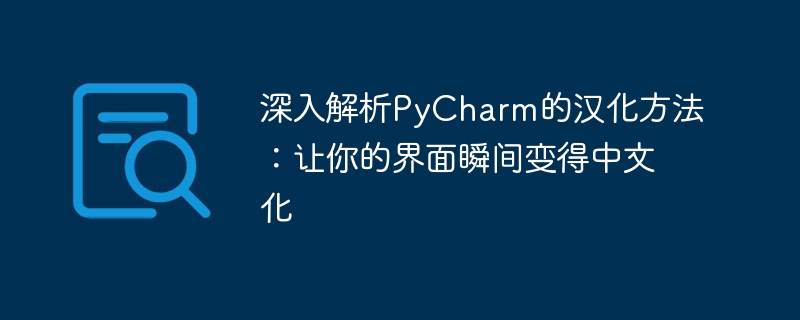

In-depth analysis of PyCharm’s Chinese language method: to make your interface instantly Chinese, specific code examples are needed
With the widespread application of Python, PyCharm is a The powerful Python integrated development environment (IDE) is favored by developers. However, the default interface language of PyCharm is English, which may cause some confusion for some non-English native developers. Fortunately, PyCharm provides the Chineseization function. This article will deeply analyze the Chineseization method of PyCharm, making your PyCharm interface instantly become Chinese. At the same time, specific code examples are also provided to give you a better understanding of how to operate.
Step one: Download the Chinese language pack for PyCharm
First, you need to download the Chinese language pack for PyCharm. On the official website or other trusted software download websites, search for the "PyCharm Chinese language pack" keyword and download the latest version of the Chinese language pack file.
For example, in Taobao, you can search for "PyCharm Chinese language package" to find language packages provided by trusted sources.
Step 2: Install the Chinese language pack
After the download is completed, open PyCharm and click "File" -> "Settings" to enter the settings interface. In the left navigation bar of the settings interface, click "Appearance & Behavior" -> "Appearance".
In the drop-down box on the right side of the theme interface, select the Chinese language pack file you downloaded. Click "OK" and PyCharm will prompt you to restart to apply the settings.
Step 3: Change the PyCharm configuration file
After restarting PyCharm, you will find that the interface has successfully changed to Chinese. However, since PyCharm itself does not provide the option of a Chinese interface, this is achieved by changing the configuration file of PyCharm. If you want the Chinese interface to be displayed by default when you open PyCharm in the future, you can follow the steps below.
First, close PyCharm.
Then, find the installation directory of PyCharm. Under Windows systems, the default path is "C:Program FilesJetBrainsPyCharm". After entering the PyCharm installation directory, find the "bin" folder, then enter the "bin" folder and find the "pycharm64.exe.vmoptions" (64-bit system) or "pycharm.exe.vmoptions" (32-bit system) file. This file is PyCharm's virtual machine parameter configuration file.
Open the "pycharm64.exe.vmoptions" or "pycharm.exe.vmoptions" file with Notepad or other text editor, and add a line of code at the end of the file:
-Duser.language=zh
After saving the file , restart PyCharm, you will find that the Chinese interface is displayed every time you open it.
Through the above three steps, you can easily implement the Chineseization of PyCharm and make the interface instantly Chinese. Of course, if you have other language pack files, you can also operate in a similar way.
Summary:
This article provides an in-depth analysis of the Chinese translation method of PyCharm, and details the steps to download the Chinese language pack, install the language pack, and change the configuration file. Through the above operations, you can quickly implement the Chinese language of the PyCharm interface and improve development efficiency.
Note: During the process of Chineseizing PyCharm, please ensure that the language pack you download is from an official or trusted source to avoid security issues. In addition, as PyCharm is updated, a new version of the Chinese language pack may be released. Please pay attention to the official website or related communities regularly to obtain the latest Chinese language pack files.
I hope this article will be helpful to you in Chinese PyCharm, and I wish you a happy Python development in the Chinese PyCharm environment!
The above is the detailed content of Detailed explanation of PyCharm Chinese version: Easily turn your interface into Chinese version. For more information, please follow other related articles on the PHP Chinese website!
 How to change pycharm to Chinese
How to change pycharm to Chinese
 pycharm installation tutorial
pycharm installation tutorial
 How to solve the problem that pycharm cannot find the module
How to solve the problem that pycharm cannot find the module
 How to install pycharm
How to install pycharm
 The difference between python and pycharm
The difference between python and pycharm
 How to configure the pycharm environment
How to configure the pycharm environment
 How to install the pycharm interpreter
How to install the pycharm interpreter
 What does pycharm mean when running in parallel?
What does pycharm mean when running in parallel?




